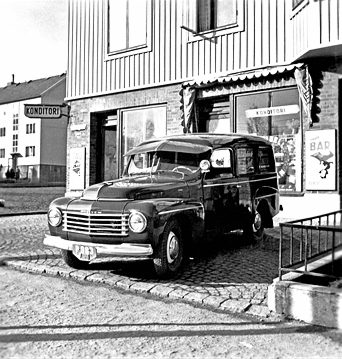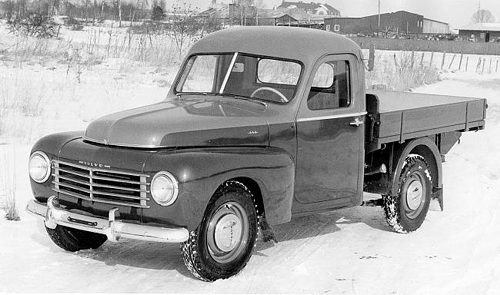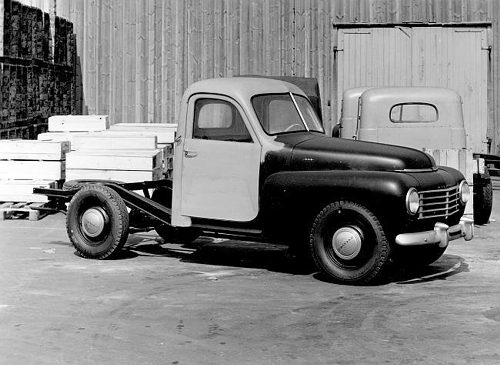

Photographs can be seen in our Volvo Gallery
Volvo PV445 celebrates its 60th anniversary
22 June 2009
In 2009, the light delivery vehicle Volvo 445 which brought about the Duett and by that started Volvo's tradition of estate cars turns 60. This is what happened.
Shortly after Volvo started making vehicles in 1927, they began to deliver bare chassis for accommodating different bodies according to customers needs The big Volvos of the 1930s were delivered from Volvo fitted with front wings, bonnet, sills and rudimentary A-pillars in order to be transformed into vans or pickup trucks by the many coachbuilders in Sweden at the time. Due to the fact that the larger Volvo cars were still built on separate frames after Word War II, these bare chassis versions were still offered in the sales catalogue throughout the 1950s but they were large so the need for a smaller and lighter chassis version became evident.
The PV444 had a unitary construction body design and therefore could not be used for this kind of vehicle. A commercial equivalent built on a strong but light separate frame had to be designed. The production of this chassis started in the summer of 1949. It was the equivalent of the PV444 in size and price. When it came to appearance, the front wings and bonnet came straight off the 444 but the 445 was distinguished from the saloon by having a grille with five horizontal chrome bars instead of four. Payload was slightly above 500kg (1000 lbs) depending on body version. A pickup was lighter and could carry more weight than a heavier van. Total weight was 1650 kg and the chassis alone counted for 725 kg, But those who used the 445 daily soon learned that the car could carry much more in practice than in theory.
The little 1.4 litre OHV four with its 40 hp was enough to propel the car efficiently in urban traffic. Its low gearing provided very good acceleration but made the cars noisy and thirsty at higher speeds on longer runs. The mechanics and equipment were all PV444 except for the rear axle which was sprung by two very rigid semi-elliptic leafsprings rather than the more comfort-oriented coil-spring suspension of the 444.
Big business
Sweden at this time had about 70 coachbuilding companies of which some 25 did different bodywork for the 445. For vans, hearses and ambulances, the bodies were invariably made from wooden frames with sheet steel panelling, so were the cabs of the pickups. Very few all-steel bodies and cabs were fitted to the 445, mainly due to time and cost reasons. The inside of these vehicles were practical rather than comfortable. Usually some type of board was used for the door sides and the upholstery was most often different makes and types of durable artificial leather. The cosiness factor was low. It was up to the driver to create a snug and comfortable working place. And that was exactly what the 445 was for its users, a place of work.
On rare occasions the 445-chassis were even fitted with convertible bodies, for instance by Nordbergs of Stockholm, Ringborgs in Norrköping and the Gävle-based company Valbo. The two latter companies even tooled up for a small series production, they built some ten cars each. Of these 20 cars, some 10 are still in existence and a handful are in perfect running condition in the loving hands of enthusiasts. Priced at more than double the cost of a PV444 when new, they were and remain rarities.
A van of our own
In a few years time Volvo filled the market with 445 chassis. The tough and long-lasting little fighters were not traded in for new ones or scrapped at the rate Volvo had expected. They were simply too good. By the beginning of 1952, Volvo found itself with 1500 unsold 445 delivery chassis parked outside the factory; cars that should have been on the road a long time ago. In parallel, more and more car manufacturers started to offer their own vans and estates, ready made from the beginning, and the coachbuilding companies were facing really hard times. But the 445s had to be sold just the same, and why the need for an outside body supplier in order to make them attractive?
"Build our own Volvo van" was managing director's Gabrielsson's directive and thus was born the Volvo Duett - Volvo's first van/estate model. Young engineer Erik Skoog and his small team went to work straight away, and designed a body for the 445 chassis which was suitable for both goods and people transport alike, ordered the necessary tools and - only 15 months later - on the 4th of July 1953, delivered the first Duett to its eager "customer", Volvo president Assar Gabrielsson.
The Duett was to become a true Volvo favourite on its own merits, the production lasted until 1969. 40 years ago this year. This car could also be delivered as bare chassis for alternative body work but such versions became more and more rare. The practical and roomy standard versions of the Duett - with or without rear side windows - could handle most small and midsize transport needs. The perfect choice for the small business.
The last frame
Just like the delivery chassis, the first Duetts were also designated the 445 with an added letter combination giving away the body type and trim level. It was not until 1960, when the car was throughly reworked that the name was changed to 210, with the Amazon estate version called the 220. The name Duett was a word play. It was two cars in one, for work and leisure. It was also the last Volvo car to be built on a separate frame and it kept its 1940s retro-look throughout its life.
Durings its last year of production, in 1969, Sweden introduced new crash test legislation and with a design dating from the late 1940s, the Duett would not stand the test. Volvo decided to end production and all but one example of the 1969 Duetts were exported. The remaining car, chassis no 97299, sits in the Volvo Museum today. It is dark blue with fawn vinyl interior and carries its original registration number OA 1075 (the OA denoting the Gothenburg area according to this system).
In the Volvo model range at that time there were already two other practical and elegant estate cars which quite often also had to carry the loads of work, the 220 Amazon and the 145.
For the enthusiast
For those who like chassis numbers and their origins, the 445 and Duett number systems are a real challenge which almost takes the skills of Sherlock Holmes to fully understand. They can be very confusing. First only bare chassis were numbered, then other types were taken in as they were added to the basic version and it is difficult to separate the types and the numbers from each other. In total, 4,194 bare chassis were produced. 4,035 of them 445 and a mere 159 were 210s. In short, the system is built up according to this:
Delivery chassis, numbered from September 1949 - May 1962 (end of production)
Estate version
Panel (Van) version
Passenger estate version (!)
210 Duett (end of production February 19th, 1969)
Total production all types incl separate chassis: 101,492



Legal | Privacy | Contact Us | Search | Site Map
Volvo Owners' Club Limited® 1962-2025

